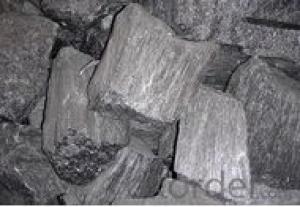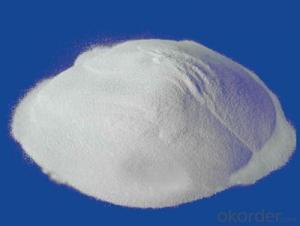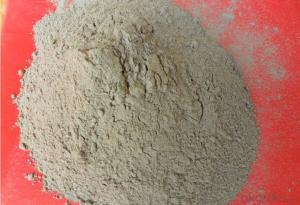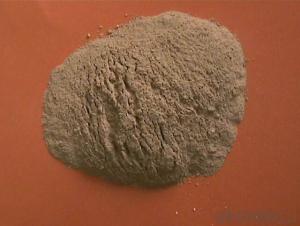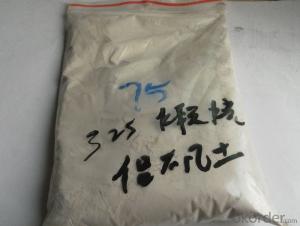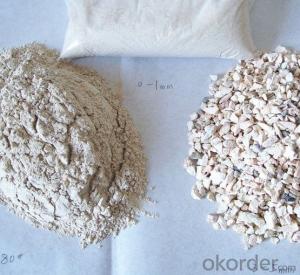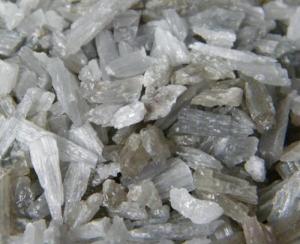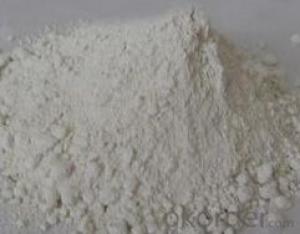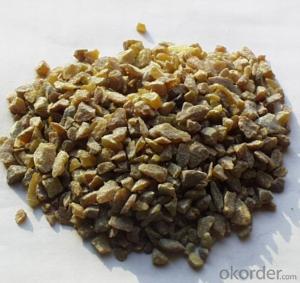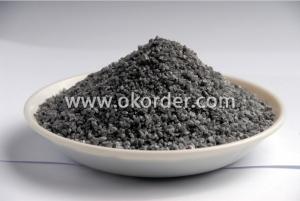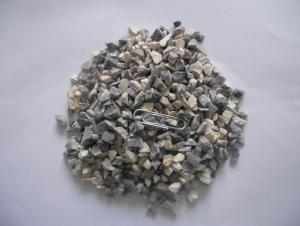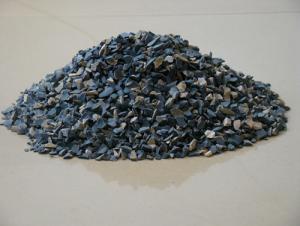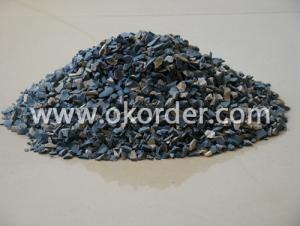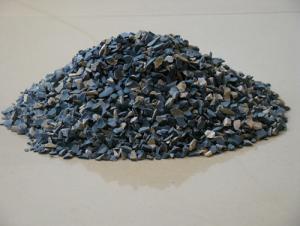Raw Materials for Refractory - High Purity Fused Mullite
- Loading Port:
- China Main Port
- Payment Terms:
- TT OR LC
- Min Order Qty:
- -
- Supply Capability:
- -
OKorder Service Pledge
OKorder Financial Service
You Might Also Like
Specifications
Fused Mullite :
1,high purity fused mullite
2,provide mullite with different grades and size
Description:
Mullite is a raw material with high heat resistance. At present, there are mainly high purity fused mullite, ordinary fused mullite, finely sintered mullite with all natural bauxite and caustic-burned mullite.
Mullite of Ruishi Brand is made of high quality pure natural mullite ore, melted from the advanced industrial furnace with high temperature. It is featured by uniform expansion, excellent thermal shock resistance, high softening point with load, low elevated temperature creep value, high hardness, good resistance to chemical corrosion etc.
Specification:
Mullite:
Specification | Item | Chemical composition(%) | ||
Al2O3 | Si02 | Zr02 | ||
AS-Ⅰ AS-Ⅱ AS-Ⅲ | Sintered | 42-47 56-67 70-76 | 51-55 28-42 23-28 | --- --- --- |
AS-I AS-Ⅱ | Fused | 60-70 70-77 | 25-35 22-29 | -- -- |
Particle size :0-1mm/1-3mm/3-5mm/5-8mm;180mesh-0/320mesh-0
Packing: 1 MT big bag or 25kg paper bag *40 bags on one pallet ;
As per customer’s requirement
Advantages:
1.expansion uniformity
2.excellent thermal shock resistance
3.high load softening point
4.small high temperature creep value
5.high hardness
6.good resistance to chemical corrosion
FACTORY:

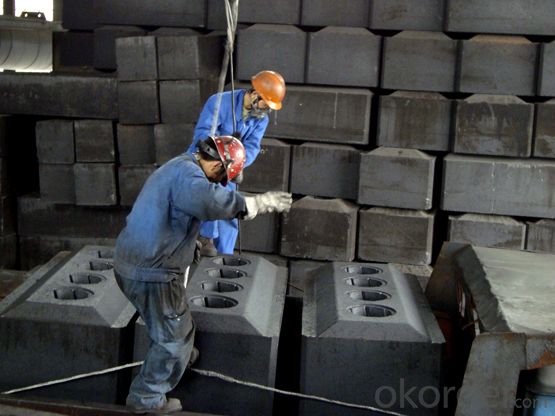
- Q: Preparation of refractory clay
- Is it to make refractories? Add some andalusite to the refractory mortar will improve the effect.
- Q: What's the feature of construction external wall fireproof and thermal inuslation matertial?
- It has properties of low heat conductivity coefficient, low density, high flexibility, fireproof and waterproof. Its heat conductivity coefficient at normal temperature is 0.018W / (K · m) . The thermal insulation property is three to eight times that of the traditional materials. And it is completely waterproof. [2] Thermal insulation lining has properties of low heat conductivity coefficient, low density, high flexibility, fireproof and waterproof. Light, generally about10-96kg / m3, 20kg / m3 or less is felt, 24-48kg / m3 is middle-hard plate, 48-96kg / m3 is hard plate, wherein 48kg / m? can be used as ceiling, with softening point being 500 ° C , thermal insulation 300 ° C. It is widely used in the United States, k =0.9. Calcium silicate thermal insulation product is developed in 1970s in China. With high compressive?strength, low heat conductivity coefficient, recycle and easily construction, it is widely used in the power system. In China, small workshop?production were the most common, then four production lines were gradually introduced from America, including instant fiber forming, dry method punched felt, which are advanced and quality, temperature endurance up to 800-1250 ° C.
- Q: What is acid refractory material?
- In fact, with the content of zirconia refractory multiple theory should also be acid refractory
- Q: What are the new refractories? What are the features? How about their application and development?
- In metallurgy, in what position should it be used, in order to make the best. Answers are as following. In iron, steelmaking or converter. When questioning, pay attention to the ways. Answers: Try to use synthetic refractory materials.
- Q: What's the definition of fire endurance of the fire-resistant coating for steel structure?
- Fire endurance (h): Under the condition of standard fire resistance test, the time when the building components, accessories, or structure is subjected to fire to the time when they loose stability, integrality or thermal insulation is called fire endurance which is showed in time. Steel is the kind of building material that is nonflammable with many properties of seismic resistance and bending resistance. In practical applications, steel can improve the load capacity of buildings in a relative way, meet the needs of buildings design, beauty and mould, and it can also avoid the defects of poor flexibility and tensile strength of buliding materials like concrete. Therefore, steel is quite popular in the construction industry, and it is widely used in single-story or multi-storey skyscrapers, plants, warehouses, waiting rooms and airport terminals, etc. However, as a kind of building material, it has some unavoidable defects in fire prevention. That is its mechanical properties like yield point, tensil strength and elasticity modulus will decrease dramatically with the rise of the temperature.
- Q: What are the differences and connections between softening temperature of the refractory under a fixed load and thermal resistant creep property of the refractory?
- The result of refractoriness under load is temperature while the result of creep is percentage of deformation. Refractoriness under load and creep can be tested by an instrument. Refractoriness under load reflects the temperature in which the deformation reaches a certain degree under the condition of load. Creep reflects the deformation refractory has under the condition of constant temperature and load. Both refractoriness under load and creep are important criterion for the operating temperature of refractory.
- Q: who knows how to classify the fire resistant levels of fireproofing material?
- Materials used in construction are called construction materials. The combustion performance of construction materials refers to all physic and chemical changes happened when burning or contacting fire, the properity is measured by combustibility of material surface and flame transmission, heating, smoke,charring, weightlessness, and the producing of toxicity resultant. Our national standard GB8624-97 classifies the combustion performance of construction materials into following several levels. Class A: Incombustible building material, class B1: Nonflammable building material, class B2: Combustible?building?materials, class B3: Inflammability construction materials, generally speaking: first fire resistant level construction is the mixed construction of reinforced concrete structure or brick wall and steel concrete structure; second fire resistant level construction is the steel structure roof truss, reinforced concrete column or mixed structure made by brick wall; third fire resistant level construction is the wood and brick made by wooden roof and brick wall; fourth fire resistant level one is the combustible?structure made by wooden roof, hard-comnustible component wall.
- Q: What is the appropiate thickness if fire resistant time for ultra thin steel structure coating is 2.5 hours?
- A level fire resistant steel structure building steel column cannot be constructed with super thin steel structure fire retardant coating, because the ultra thin steel structure fire retardant limit is less than 3 hours. Thin fire retardant coating for steel structure is water borne fireproof coatings painted on the surface of steel structure. It will form carbonized fireproof heat insulation protective layer to insulate oxygen and delay the speed of heating steel structure when it catches on fire, avioding the rapid temperature rise of steel structure and increasing its fire resistant limit. Fire resistance performance: The 2mm coating ≥ 60min, 3mm 100min.
- Q: Can polystyrene foam color steel plate be used as decorative fireproofing material ?
- No, only non-combustible product can prevent fire. Most polystyrene foam boards are flammable which cannot prevent fire. Polyphenyl can only retard flame, highest fire?retardant fire?rating being B1 level. Under the same conditions, fireproof performance of polystyrene foam board will be better because most extruded sheets are made by recycling materials and contain much more impurities which will affect flame resisting property. The second reason is that high temperature in extruded sheet manufacturing technique will decompose part of flame retardants. For B1 level extruded sheet, it is difficult to reach 30 burning oxygen index, while for B2 level, it is hard to reach 32. So polyphenyl board is safer.
- Q: What are the materials of class A fire resistant window?
- Environmentally friendily, non-poisoned non-peculiar smell, non-radioactive; non-combustible, fireproof, moisture-proof, corrosion-resistant; easy to operate, lightweight, high strength, themal insulation, sound insulation; able to be cut, planed, sawed and carved. It also meets GB8624 -2006A1 level non-combustible standards. Lightweight, high strength, anti-aging, corrosion resistance; meeting the GB / T20285-2006 Opium (AQ1) safety and environmentally friendly products; Foamed fire door core board specifications: 2100 × 900 × (26 ~ 65) mm; 2050 × 850 × (26-65), and many other specifications. I hope my answer can help you.
Send your message to us
Raw Materials for Refractory - High Purity Fused Mullite
- Loading Port:
- China Main Port
- Payment Terms:
- TT OR LC
- Min Order Qty:
- -
- Supply Capability:
- -
OKorder Service Pledge
OKorder Financial Service
Similar products
Hot products
Hot Searches
Related keywords
